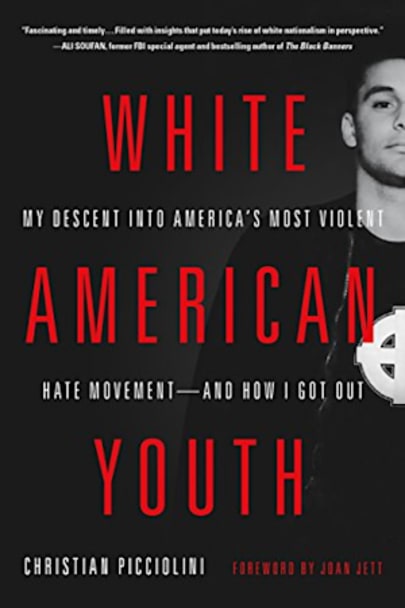A stunning look inside the world of violent hate groups by a onetime white supremacist leader who, shaken by a personal tragedy, realized the error of his ways and abandoned his destructive life to become an anti-hate activist. As he stumbled through high school, struggling to find a community among other fans of punk rock music, Christian Picciolini was recruited by a now notorious white power … notorious white power skinhead leader and encouraged to fight with the movement to “protect the white race from extinction.” Soon, he had become an expert in racist philosophies, a terror who roamed the neighborhood, quick to throw fists. When his mentor was arrested and sentenced to eleven years in prison, sixteen-year-old Picciolini took over the man’s role as the leader of an infamous neo-Nazi skinhead group.
Seduced by the power he accrued through intimidation, and swept up in the rhetoric he had adopted, Picciolini worked to grow an army of extremists. He used music as a recruitment tool, launching his own propaganda band that performed at white power rallies around the world. But slowly, as he started a family of his own and a job that for the first time brought him face to face with people from all walks of life, he began to recognize the cracks in his hateful ideology. Then a shocking loss at the hands of racial violence changed his life forever, and Picciolini realized too late the full extent of the harm he’d caused.
Raw, inspiring, and heartbreakingly candid, White American Youth–winner of the 2017 Raven Award–tells the fascinating story of how so many young people lose themselves in a culture of hatred and violence and how the criminal networks they forge terrorize and divide our nation.more



The bullet points alone create compelling “curb appeal” and make this story an easy sell. Born to Italian immigrant parents in the early ’70s, Picciolini is an adorable little boy. Growing up in a small town outside of Chicago, he comes of age during the mid ’80s. Seeking his “place in the world,” he’s driven to achieve greatness — to become a champion athlete or a life-saving hero. However, Picciolini’s all-American ambition soon turns to a misguided, out of control hunger for power and glory. And by age 15, he’s on the fast track to building one of America’s most violent homegrown terror organizations. Fortunately, by his mid 20s, came repentance.
But “White American Youth” (originally titled “Romantic Violence”) is more than a riveting, good boy-turned-monster-finds redemption saga. And the true payoff is the story behind the bullet points. From family members and friends to a menagerie of “white trash thugs,” Picciolini paints compelling portraits of the people who played key roles in his disturbing life story. His attention to details is superb — from pointing out his father’s pinkie ring to his mother’s hair-dyed fingertips. Piccionli uses a fine-tipped brush to make his story zing — recalling with vivid clarity, early memories of his parents who were too consumed with running their salon to offer him what he yearned for most — their time and attention. Typically the last kid to be picked up from school by his parents each afternoon, then rushed immediately and dropped off at his grandparents’, Picciolini writes that he often felt like “a burden unloaded.” Hmm, and so it begins.
His narrative is brutally honest. His language — unfiltered, crude and often offensive. And the transparent accounts of his actions during his rebellious, hate-filled youth are beyond despicable. However, Picciolini assumes complete responsibility for the choices he made — choices that left him ultimately filled with “dread and regret” — a period in his life that he now looks back on as being “pathetic” and a “miserable existence.”
Picciolini’s heartfelt accounts — the connection to his younger brother, “Buddy,” discovering teenage love, and his passion for the punk scene’s glory days of Social Distortion, mix tapes and “zines,” often help to humanize the seemingly heartless beast. As a result, I kinda understood him. Not that I could ever condone his past acts of violence and racism in any way, I just felt like, “Hey, I know this guy.” In fact, if the reader can remove their own emotions regarding the story’s glaring hate factor and look closely, Picciolini will likely seem familiar, and I dare say, endearing to many.
Despite possessing an arguably overall “fabulous” fashion sensibility, I’m actually a real “tough guy” inside. From my days procuring groupies and meds for platinum-selling rock stars to watching a close family member die of AIDS to surviving a painful divorce — losing everything in the process, to raising my (now) adult son and my current international missionary experiences, I’ve pretty much seen it all in my 52 years. But as I finally finished reading “White American Youth” one morning last week, I found myself so moved, that my trembling hands could literally no longer hold the (now) coffee-stained print copy — prompting me to leave it sitting atop the bar at my local Starbucks — wiping away the tears streaming down my scruffy, middle-aged face as I stepped outside to collect my composure.
Bravo, Mr. Picciolini — “payoff,” indeed.
-Christopher Long
(June 2015)